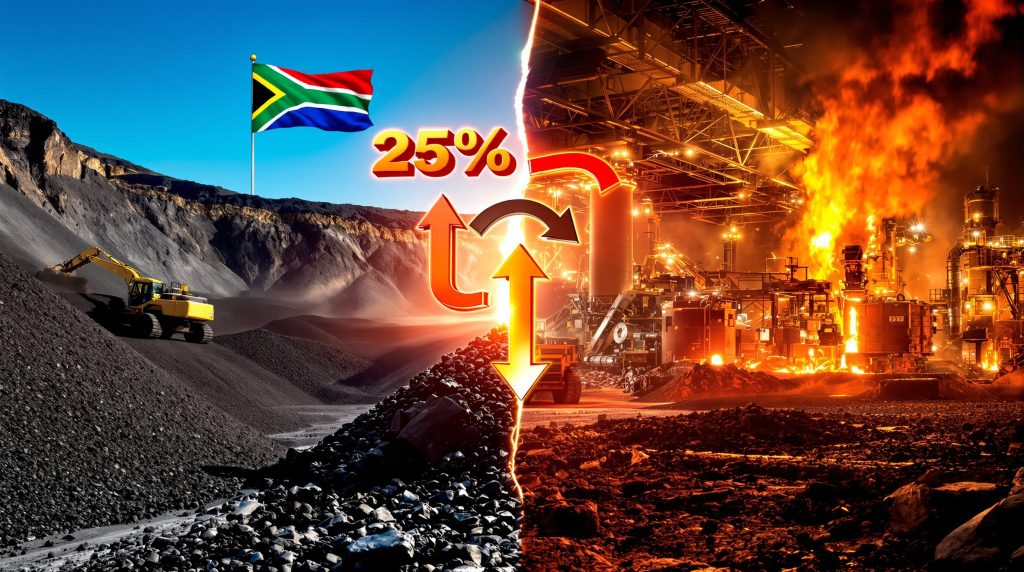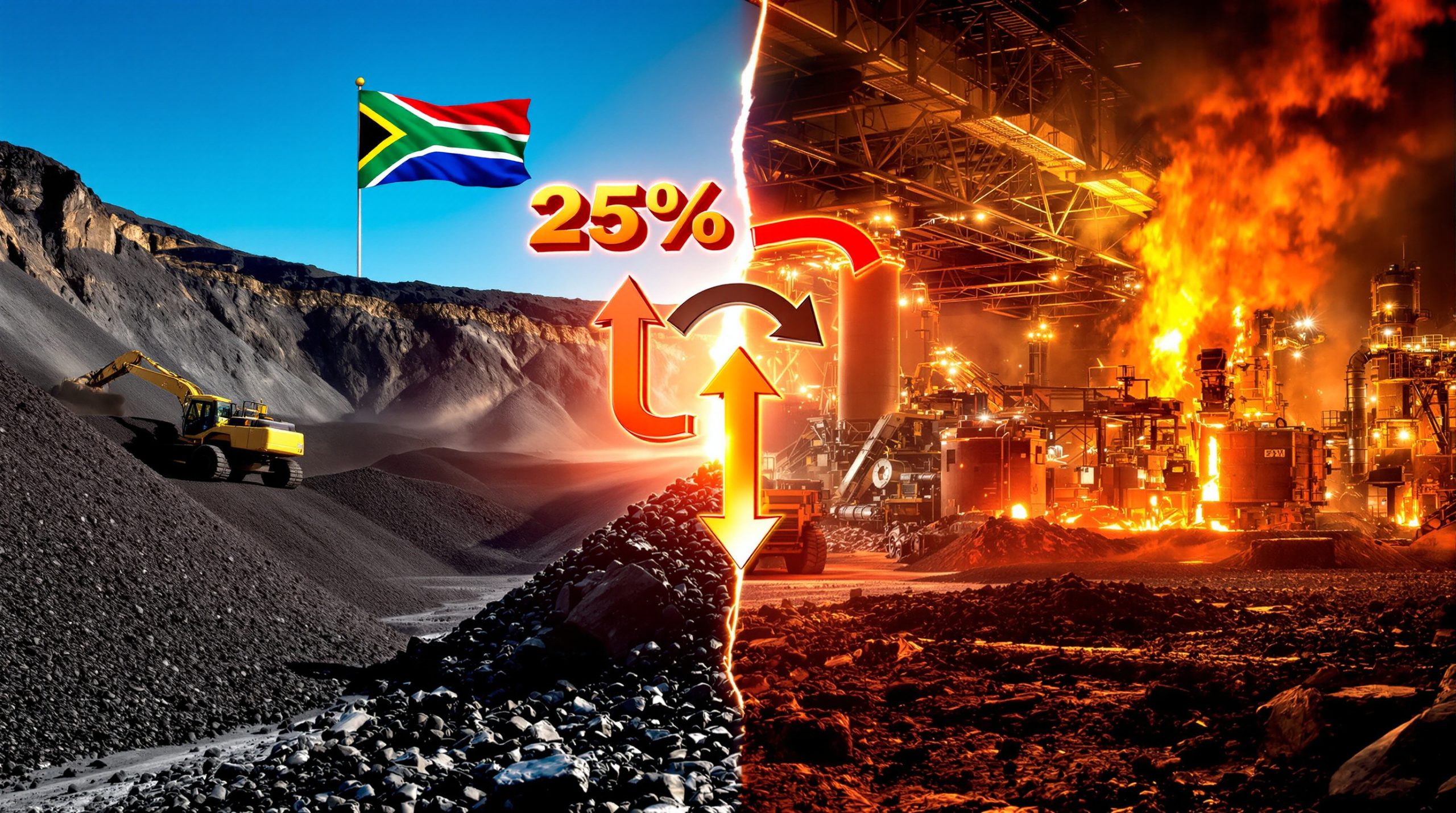What is the Proposed Chrome Export Levy in South Africa?
The 25% Export Duty Proposal
South African authorities are considering implementing a 25% levy on raw chrome ore exports as part of a draft economic growth strategy. This proposal aims to support the struggling domestic ferrochrome sector by maintaining lower domestic chrome prices while simultaneously introducing preferential power tariffs for ferrochrome producers. The framework has broader economic goals, targeting 3.5% economic expansion and increased investment in fixed assets by 2030.
The proposal represents one of the most significant interventions in South Africa's mineral beneficiation opportunities designed to shift the country's economic profile from primarily resource extraction toward value-added processing and manufacturing.
Current Status of the Policy
The South African Cabinet has already approved an export tariff in principle, though without specifying the exact rate. Additionally, new permit requirements administered by the International Trade Administration Commission have been introduced as part of export control measures. These policy developments indicate a clear government intention to regulate chrome exports more stringently.
Implementation timelines remain under discussion, with industry stakeholders advocating for a phased approach that would allow mining operations and supply chains to adjust gradually to the new regulatory framework.
Why is South Africa Implementing Chrome Export Controls?
Strategic Importance of Chrome Resources
South Africa possesses over 70% of global chromite reserves, making it the dominant player in the chrome market. Chromite is the primary ingredient in ferrochrome production, which is essential for manufacturing stainless steel. This resource abundance gives South Africa significant leverage in the global chrome supply chain.
The country's chromite deposits are predominantly found in the Bushveld Igneous Complex, one of the world's largest layered intrusions containing the highest-grade chromite reserves globally. This geological advantage provides South Africa with chromite ores that typically contain 40-50% Cr₂O₃, compared to global averages of 30-35%.
Crisis in the Ferrochrome Industry
The South African ferrochrome sector has been severely impacted by escalating electricity costs, resulting in approximately 14 smelter closures in recent years. This has led to the elimination of an estimated 350,000 jobs throughout the ferrochrome supply chain. Major producers like Glencore have announced redundancies at facilities operated with Merafe Resources, affecting sites in Rustenburg and other locations.
The industry's decline is particularly concerning given South Africa's already high unemployment rate, which reached 32.9% in early 2025. The ferrochrome sector has traditionally provided stable, skilled employment in economically disadvantaged regions.
Competitive Disadvantages
The ferrochrome industry faces critical challenges:
- Above-inflation electricity cost increases that have reached 15-20% annually in recent years
- International competition, particularly from China, which now produces over 60% of global ferrochrome despite minimal chrome ore reserves
- Operational inefficiencies including aging infrastructure and technology
- Infrastructure constraints such as unreliable electricity supply and logistical bottlenecks
These challenges have created a paradoxical situation where South Africa has unparalleled chromite resources but struggles to maintain its position in the higher-value ferrochrome market.
What Are the Potential Economic Impacts of the Chrome Export Levy?
Revenue Generation Potential
According to calculations by Menar managing director Vuslat Bayoglu, a 25% levy could generate approximately R34 billion annually based on current prices and export volumes. This substantial revenue could potentially fund electricity relief programs for smelters, addressing one of the industry's most pressing challenges.
This revenue stream represents approximately 2.1% of South Africa's total tax revenue collection, making it a potentially significant contributor to the national fiscus. The government has indicated this revenue would be ring-fenced specifically for electricity relief and industry development rather than absorbed into general revenue.
| Potential Revenue Scenarios | Annual Amount (ZAR) |
|---|---|
| Conservative estimate (low prices/volumes) | R25 billion |
| Base case (current prices/volumes) | R34 billion |
| Optimistic scenario (high prices/volumes) | R42 billion |
Foreign Currency Earnings at Risk
Chrome ore exports earned South Africa R84 billion in foreign currency last year, according to industry representatives. Chrome SA, representing major mining companies including Sibanye-Stillwater and Tharisa, argues that export restrictions could jeopardize this significant source of foreign exchange.
The potential loss of foreign currency earnings comes at a challenging time for the South African economy, which has experienced a weakening rand and pressure on its balance of payments. Foreign reserves stood at approximately $60 billion as of mid-2025, providing around 6 months of import cover.
Employment Implications
The ferrochrome industry's decline has already threatened up to 250,000 positions. With just eight of 80 furnaces currently operational, the sector faces severe employment challenges. The export levy aims to preserve and potentially restore some of these jobs by revitalizing domestic ferrochrome production.
Employment considerations are particularly significant given that:
- Ferrochrome production creates approximately 3-4 times more jobs per ton of chrome ore processed than mining alone
- The sector employs a high percentage of skilled and semi-skilled workers with significant training investment
- Many ferrochrome operations are located in economically disadvantaged regions with few alternative employment opportunities
How Are Industry Stakeholders Responding to the Export Levy?
Mining Companies' Opposition
Chrome ore miners have strongly condemned the proposal, arguing it would be counterproductive. Chrome SA contends that export restrictions would damage already marginal operations while failing to address the fundamental issue of electricity affordability.
The mining sector has presented economic impact assessments suggesting that up to 30% of chrome mining operations could become financially unviable under the proposed levy, potentially resulting in mine closures and further job losses in mining communities.
Ferrochrome Producers' Perspective
The Ferro Alloy Producers Association has expressed ambivalence about the tax, prioritizing action against illegal mining, which accounts for approximately 10% of chrome exports. Chairman Nellis Bester emphasizes that competitive electricity tariffs represent the only viable long-term solution for the industry's survival.
Industry leaders have highlighted that even with reduced chrome ore prices, South African ferrochrome production costs would remain approximately 15-20% higher than Chinese competitors without addressing the electricity price disparity.
Table: Key Stakeholder Positions on Chrome Export Levy
| Stakeholder | Position | Primary Concern | Proposed Alternatives |
|---|---|---|---|
| Government | Supportive | Protecting ferrochrome industry and jobs | Targeted electricity tariff relief |
| Chrome SA (miners) | Opposed | Impact on mining operations and foreign currency earnings | Direct subsidies for ferrochrome producers |
| Ferro Alloy Producers | Ambivalent | Prioritize electricity tariffs and combating illegal mining | Energy cost relief and illegal mining enforcement |
| Menar (Vuslat Bayoglu) | Supportive | Revenue generation for electricity subsidies | Graduated implementation timeline |
| Labor unions | Conditionally supportive | Job preservation in both sectors | Skills development and worker transition programs |
What Alternatives Exist to Support the Ferrochrome Industry?
Electricity Tariff Reforms
The Ferro Alloy Producers Association emphasizes that competitive electricity tariffs are the most critical factor for industry survival. Recent negotiations between Electricity Minister Kgosientsho Ramokgopa, Glencore, Samancor, and Eskom have yet to yield a resolution to the electricity cost challenge.
Industry analysts estimate that ferrochrome production requires approximately 3,300-3,800 kWh per ton, making electricity costs account for 35-40% of total production expenses. A dedicated electricity tariff structure that recognizes the strategic importance of the sector could potentially be more effective than export restrictions.
Combating Illegal Mining
Industry stakeholders highlight the need to address illegal chrome mining, which accounts for approximately 10% of exports. Curbing these illicit operations could help stabilize the legitimate industry and improve market conditions.
Illegal chrome mining has grown substantially, particularly in the eastern limb of the Bushveld Complex, where small-scale unauthorized operations extract and sell chrome ore through informal channels, often at prices that undercut legitimate producers.
Investment in Energy Efficiency
Improving energy efficiency in ferrochrome production could help reduce operational costs and enhance competitiveness without relying solely on tariff protection or subsidies.
Recent technological innovations in smelting processes have demonstrated potential energy savings of 15-20% compared to conventional methods. Several South African ferrochrome producers have begun pilot programs utilizing these more efficient technologies, though capital constraints have limited widespread adoption.
What Are the Global Market Implications?
Impact on International Chrome Supply
As the holder of 70% of global chromite reserves, South Africa's export policies significantly influence global chrome supply and pricing. The proposed export levy could potentially reshape international trade flows and pricing structures.
Historical precedents suggest significant market disruption is likely. When India implemented chrome ore export restrictions in 2007, global prices increased by approximately 30% within six months before new supply chains adjusted to the changed market conditions.
Chinese Ferrochrome Industry Response
China, a major importer of South African chrome ore and producer of ferrochrome, may need to adjust its sourcing strategies or production methods in response to South Africa's export restrictions.
Chinese ferrochrome producers have already begun diversifying supply sources, increasing imports from countries including Zimbabwe, Turkey, and Kazakhstan. However, these alternative sources cannot fully replace South African volumes, potentially forcing Chinese producers to accept higher input costs or accelerate development of chrome recycling technologies.
Potential for Market Restructuring
The export levy could trigger a restructuring of the global chrome and ferrochrome market, potentially leading to increased vertical integration or the development of alternative supply chains.
"The proposed export levy could fundamentally alter the economics of the global ferrochrome industry. We may see increased investment in vertically integrated operations that control both mining and smelting, as well as accelerated research into chrome substitutes and recycling technologies." – Mining industry analyst quoted in Business Times, 2025
How Does This Policy Fit Into South Africa's Broader Economic Strategy?
Resource Nationalism Trend
The chrome export levy reflects a broader trend of resource nationalism, where countries seek to capture more value from their natural resources by encouraging domestic processing rather than raw material exports.
This approach aligns with similar policies implemented across various mineral commodities in South Africa and other resource-rich nations. Indonesia's nickel export ban, implemented in 2020, provides a notable parallel, having successfully stimulated domestic processing capacity and attracted substantial investment in downstream industries.
Industrial Development Goals
The policy aligns with South Africa's industrial development objectives, aiming to move up the value chain from raw material extraction to higher-value manufacturing and processing.
The government's Industrial Policy Action Plan specifically identifies mineral beneficiation as a priority sector for development, with chrome and ferrochrome highlighted as strategic value chains with significant growth potential. The export levy represents a concrete implementation of this broader industrial strategy.
Economic Growth Targets
The draft economic growth strategy, which includes the chrome export levy proposal, targets 3.5% economic expansion and increased investment in fixed assets by 2030, indicating the policy's role in broader economic planning.
This target represents a significant increase from South Africa's average growth rate of 0.9% from 2015-2025, suggesting policymakers view structural reforms like the South Africa chrome export levy as essential to breaking out of the country's low-growth trajectory.
What Are the Implementation Challenges?
Balancing Competing Interests
Policymakers face the challenge of balancing the interests of chrome miners, who benefit from export opportunities, with those of ferrochrome producers, who seek protection and support.
Finding this balance requires sophisticated policy design, potentially including:
- Graduated implementation timelines allowing for industry adjustment
- Targeted relief measures for vulnerable mining operations
- Mechanisms to ensure benefits reach workers and communities
- Clear metrics for evaluating policy effectiveness
Electricity Supply Constraints
Even with financial relief, ferrochrome producers continue to face energy security concerns that may limit production capacity regardless of export policies.
South Africa's electricity generation capacity has improved since the severe load-shedding crisis of 2022-2023, but reliability issues persist. The ferrochrome industry requires not just affordable electricity but also consistent, uninterrupted supply to maintain the high temperatures necessary for smelting operations.
Monitoring and Enforcement
Implementing effective monitoring and enforcement mechanisms to prevent circumvention of the export levy presents significant administrative challenges.
Previous resource export controls have faced implementation challenges, including:
- Misclassification of materials to avoid duties
- Trans-shipment through neighboring countries
- Under-invoicing to reduce tariff exposure
- Growth in illicit supply chains
Addressing these challenges will require enhanced customs capacity, inter-governmental coordination with neighboring states, and potentially new tracking technologies such as blockchain-based mineral certification systems.
The Future of South Africa's Chrome Industry
The proposed 25% chrome export levy represents a significant policy intervention aimed at reversing the decline of South Africa's ferrochrome industry. While the immediate goal is protecting jobs and revitalizing smelting operations, the policy raises fundamental questions about how resource-rich countries can best leverage their natural advantages in the global economy.
The success of this policy will depend not only on its technical design but also on complementary measures addressing the industry's broader challenges, particularly electricity costs and supply reliability. Stakeholders across the value chain are navigating substantial uncertainty as the policy takes shape, with potential global tariff impact throughout stainless steel supply chains.
As implementation proceeds, policymakers will need to monitor outcomes carefully, remaining flexible enough to adjust the approach if unintended consequences emerge. The South Africa chrome export levy represents not just an industrial policy tool but a test case for South Africa's broader critical minerals strategy in an increasingly complex global marketplace where tariffs affecting supply chains have become more common.
Disclaimer: This analysis includes forecasts and speculative assessments of policy impacts that are subject to significant uncertainty. Market conditions, policy implementation details, and industry responses may differ substantially from the scenarios presented.
Want to Spot the Next Big Mineral Discovery Before the Market?
Discovery Alert's proprietary Discovery IQ model instantly identifies significant ASX mineral discoveries, transforming complex geological data into actionable investment insights for both traders and long-term investors. Explore historic returns from major discoveries on the dedicated discoveries page and position yourself ahead of the market.




